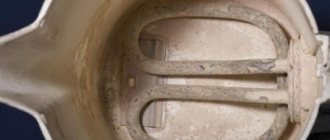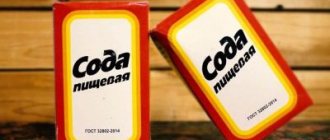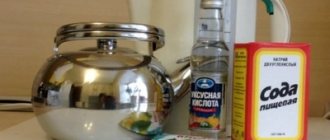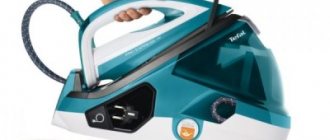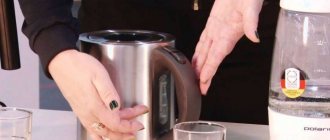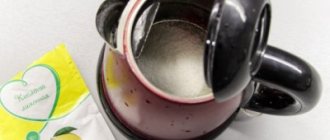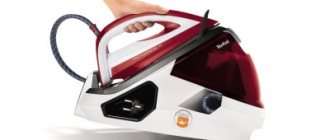In the modern world, an electric kettle has long become an indispensable household appliance. It has earned its popularity due to its independent shutdown when boiling and the high speed of heating water. However, like any kitchen aid, it is prone to breakdowns. Over time, an electric kettle from any brand leaks - this is due to the natural wear and tear of the material from which it was made. A leak is dangerous not only due to the constant formation of puddles around the device, but also the possibility of receiving an electric shock. In this regard, the question arises of what can be used to seal an electric kettle before purchasing a new one, because it poses a danger to users.
Types of material for making electric kettles
Models of teapots differ in appearance and body material. The principle of operation is the same for all products. The water is heated by a heating element (heating element) located at the bottom of the flask. There is also a thermostat installed there that disconnects the device from the electrical network.
Plastic
Plastic material is cheap, so teapots with plastic bodies are inexpensive. Not only the affordable price attracts buyers. Products of this type have a wide range of colors. Designers decorate the cases with drawings and original inserts made of various materials. Plastic electric kettles look attractive, but have disadvantages:
- when heated, a smell appears;
- Poor quality material releases harmful substances into the water.
Products from Philips and Bosch do not have these disadvantages. They produce devices with housings made of food-safe plastic.
Glass
Heat-resistant glass is used in the production of teapots. It is 100% safe for health. When used correctly, household glass products have high strength parameters. Electric kettles with a glass bulb fit well into the interior of a modern kitchen.
Advantages of glass electric kettles:
- chemical inertness of glass, it does not enter into compounds;
- the use of color lighting increases the decorative properties of the product.
There are downsides. The first is the fragility of glass flasks when dropped from a height. The second is special care for the glass surface. In its absence, the product loses its attractiveness.
Metal
The kettle flask is made of stainless steel. It is complete and leaks extremely rarely. The problem area is the place where the heating element (heater) is attached. For household models with a body made of metal, water leaks in 3 cases:
- the fastening of the heating element is loose;
- cracks have formed in the gasket;
- the bottom is rusty.
Ceramics
The kitchen is cozy if there is an electric ceramic kettle on the table. The products have an original design and fit harmoniously into the interior of a modern kitchen. The material has good thermal insulation properties. The water does not cool down for a long time, but heats up quickly. At high temperatures, food ceramics do not emit harmful substances.
The most common faults
The following malfunctions are typical for electric kettles:
- Failure of the heating element. The cause of the defect is scale formed on the heating element, which makes it difficult to transfer heat to water, and the coil itself heats up. Heating elements of the spiral type are more susceptible to such damage than disk heating elements, which require more time to form a critical layer of scale. The reason for the burnout of the heating element can also be a violation of the operating rules, for example, if the kettle was plugged in, forgetting to pour water into it.
- The electric kettle power button is broken. There are two possible reasons for this: the formation of carbon deposits and oxidation on the contacts of the button, or a break in the rod connecting it to the power supply terminals.
- Leakage in the housing of an electrical appliance. This malfunction is more typical for kettles with a plastic body, as well as those equipped with a disk heating element. In the first case, the breakdown may be a consequence of deformation of the kettle due to overheating at the place where the heating element is attached, and with disk heaters, the cause is corrosion along the seam connecting the disk to the body of the electric kettle. Often the cause of such a breakdown is a deteriorated seal or cracked glass of the water level indicator.
- Premature shutdown of an electrical appliance. This malfunction is a consequence of scale. The water does not have time to boil, but the heating element has already overheated and the thermostat disconnects the device from the network.
- Failure of the thermostat. The design of electric kettles with a thermostat contains additional components and parts - a thermometer, temperature sensors, a memory unit, an electronic board and a control panel. The more parts a device has, the lower its reliability and the higher the likelihood of any of them breaking. In kettles with thermostats, the regulator itself most often fails, in which the contacts oxidize or burn.
Breakdowns that allow you to return the electric kettle to the store
You can return a faulty electric kettle to the store during the warranty period if during this period its significant shortcomings have appeared, namely the following faults:
- irreparable damage;
- periodically repeated breakdown of the same unit;
- a breakdown that cannot be repaired without disproportionate costs close to the cost of the kettle itself;
- a malfunction that requires a long time to eliminate, as a result of which the device cannot be used for more than 30 days throughout the year.
There can be a variety of malfunctions here, but the most serious of them are leaks not associated with mechanical damage and leaky gaskets, but arising due to deformation of the housing or damage as a result of corrosion processes.
Significant breakdowns include the failure of the heating element, provided that the kettle was used correctly and there is no scale on the heating element.
Electric kettles are household appliances that are included in the list of technically complex goods. Therefore, you can return them back to the store with a refund of the money paid only if they are of inadequate quality. When contacting the store with a written complaint, you need to indicate a breakdown that is often repeated or requires costs. comparable to the cost of an electric kettle.
The seller has the right to offer the buyer to contact the service center, but if the breakdown has not been fixed within 20 days, the store is obliged to return the money or exchange the device for a new one. The seller also has the right to appoint, at his own expense, an examination of the product, which will determine whether the breakdown was caused by the user or whether it is caused by a manufacturing defect. In the first case, the buyer must reimburse all costs for the examination. In the event of a defect due to the fault of the manufacturer, you can demand not only a refund, but also compensation for moral damages. Moral damage can only be claimed by a court decision.
How can you seal a glass electric kettle?
Sometimes there is no money to buy a new kettle. Sometimes there is no time or desire to go to the store. In such cases, you can revive an old but favorite kitchen gadget. You can seal a leaky flask with a substance that satisfies a number of requirements:
- non-toxic;
- there are no restrictions for use in the food industry;
- withstands high temperatures;
- elastic;
- dries quickly at room temperature;
- has adhesive properties.
On forums, craftsmen give advice on what and how to glue a leaking teapot. You cannot use recipes that include:
During operation, they release substances into boiling water that are harmful to health. In addition, they are not plastic and become brittle when exposed to high temperatures.
Food grade silicone sealant RTV 118Q
The lower limit of the operating temperature range is -60 °C, the upper limit is +260 °C. RTV 118Q sealant is used to glue glass, ceramics, metal, rubber, and plastic. It is approved for use in the food industry. It takes 72 hours to dry completely. It is convenient to use the product. The paste-like mass is easy to apply to the surfaces to be bonded.
OTTOSEAL S27
The lower limit of the operating temperature range is -40 °C, the upper limit is +180 °C. OTTOSEAL S27 is approved for use in the food industry. This silicone sealant glues glass together without applying a primer. It takes 24 hours to dry completely.
General rules for gluing
No need to guess how to seal a teapot. The technology for such repairs has long been known and tested by home craftsmen. First of all, degrease the surface and use:
The remaining solvent is washed off with warm water. Wait until the surfaces to be glued dry. Moisture impairs adhesion—the bond of glue (sealant) to the surface of the kettle. The adhesive is injected into the crack with a syringe.
Each sealant has a characteristic - vulcanization time. It is indicated in the instructions for use and depends on several parameters:
- room temperature;
- air humidity;
- thickness of the applied layer.
After sealing the crack, the kettle should sit for the required time. When the sealant is completely dry, boil the water. They don't drink it. Drain into the sink. Repeat this 3 times. This procedure prevents harmful substances from entering the body.
What to do if the bottom leaks
Seeing a puddle on the table next to the kettle, they find out the location of the leak. If it flows from below, analyze the bottom. To do this, remove it:
- work with a screwdriver;
- unscrew the screws, there are several of them;
- remove the heating element and sealing gasket.
The removed parts are inspected. Determine the cause of the leak. If there is no visible damage, remove plaque from the parts, wipe them, return them to their place, firmly fix the parts, tightening the fasteners with a screwdriver. If the leak resumes, the procedure is repeated, and the gasket is replaced during assembly.
Mechanical damage to the bottom is not repaired at home or in the workshop; they go to the store to buy a new kettle. Corrosion is the cause of cracks at the bottom. It appears on household appliances with a metal body. Because of this, microcracks form at the bottom, and it is through them that water leaks.
Useful tips
If a minor leak is detected, there is no need to rush to apply a patch. Sometimes it's better to wait a few days. The scale that constantly appears during operation of the kettle can itself heal a small microcrack .
Important! It is prohibited to repair the flask using adhesives that do not have the “non-toxic” mark on the label. The use of such products is fraught with poisoning of the body.
To keep your new kettle from leaking for as long as possible, you should boil filtered water. This will ensure the safety of the sealing gasket, which in turn will guarantee reliable tightness of the housing.
Despite official statements from service workshops about the impossibility of high-quality and warranty repair of a leaking electric kettle, there is no need to rush to buy a new device. Repairs using modern universal adhesive mixtures will give the device a second life and bring tangible savings to the family budget.
Features of working with metal and ceramic products
Gaps in electrical metal products appear at the junction of the body and the bottom. The reason for their appearance is corrosion. A rusted body cannot be restored. If the leak is due to a defective o-ring, replace it:
- unscrew the self-tapping screws with a Phillips screwdriver;
- remove the disc along with the gasket;
- evaluate the appearance of the heating element; if there is no visible damage, it is cleaned of traces of scale;
- replace the silicone gasket;
- the heating element is returned to its place;
- secure the bottom with self-tapping screws;
- the kettle is placed on a paper towel;
- pour water;
- if after 10-15 minutes the towel is dry, the kettle is plugged in.
If the rules of operation are violated, chips and cracks appear on a ceramic flask. They are sealed with heat-resistant silicone sealant RTV 118Q. It adheres well to ceramics and retains its strength at high temperatures.
Causes of failure
Of course, repairing an electric kettle can only be done by a person who understands electronics and has experience working with such devices. If these skills are missing, it is better to contact a service that deals with such repairs.
Before making a decision, it is very important to find out the reason for the failure of the electric kettle and its nature. Basically, all damage is divided into several types
Each has its own characteristic differences:
- Formation of a crack on the scale indicating the liquid level. It is usually made of plastic, which begins to crack due to high temperatures.
- Mechanical damage to the housing has occurred. For example, cold water was poured into the kettle immediately after the boiling water was drained. As a result, microcracks may appear in weak areas and the integrity of the case will be compromised.
- The heating element is poorly fixed.
- Corrosion has formed on the bottom of the kettle. The consequence of this formation is the appearance of a gap between the bottom of the device and its body.
Rules of care and use
Compliance with operating rules and proper care will extend the life of the household device. For example, glass teapots do not like cold water being poured into a hot flask. Microcracks appear on the walls. The structure of ceramics, plastic, and glass is badly affected by impacts. Teapots should not be dropped or placed rigidly on the table or stove. The parameters of the material change when overheated. It happens in 3 cases:
- The thermal fuse has failed;
- the contacts of the circuit breaker have oxidized;
- turned on the kettle without water.
A kettle with a faulty thermostat is replaced with a new one. This malfunction cannot be repaired. Oxidized contacts are cleaned with sandpaper. When operating a kitchen electrical appliance, you should adhere to the recommendations given in the universal instructions. It is suitable for all types and models of electric kettles.
| No. | Parameter | Description |
| 1 | Installation location | Non-slip, smooth, dry surface |
| 2 | Distance from outlet | Minimum |
| 3 | Water volume | Not below the “Min” indicator, not above o |
| 4 | Kettle lid | Before turning on, it is closed all the way; if there is a gap, the boiling kettle will not turn off |
| 5 | Stand | Do not use a stand from another kettle |
Limescale is the main cause of breakdowns of electric kettles. To avoid this, the water is filtered. The type of filter is selected depending on the characteristics of tap water. To prevent salt deposits, follow simple rules:
- do not boil the same water multiple times;
- at night and during breaks in operation, the liquid from the flask is drained;
- The surface is cleaned from limescale using folk remedies, a solution of citric acid, baking soda or table vinegar is poured into a kettle and boiled.
A high-quality kettle, if the operating rules are followed, does not leak and lasts longer than the period specified in the warranty card. Those who responsibly approach the choice of model and pay attention to the company and case material save their money.
Source
How to disassemble correctly
To disassemble the iron you will need:
- sharp knife;
- Screwdriver Set;
- pliers.
Depending on the nature of the problem, you may need a multimeter, sandpaper, insulating material and a soldering iron with solder and flux. It is recommended to start the analysis with visible fasteners. At the first stage, you need to unscrew every screw that comes into view. After this, remove the cover from the back.
Then you need to pull up the main part of the device, which is attached to plastic latches. The latter are prying with a knife
It is important to be careful at this stage as excessive force will cause the latches to break. If there are screws on the outside of the case, these elements also need to be unscrewed
How can you seal a leaking electric kettle?
In the modern world, an electric kettle has long become an indispensable household appliance. It has earned its popularity due to its independent shutdown when boiling and the high speed of heating water. However, like any kitchen aid, it is prone to breakdowns. Over time, an electric kettle from any brand leaks - this is due to the natural wear and tear of the material from which it was made. A leak is dangerous not only due to the constant formation of puddles around the device, but also the possibility of receiving an electric shock. In this regard, the question arises of what can be used to seal an electric kettle before purchasing a new one, because it poses a danger to users.
The refrigerator arrived today!
Today they brought me a Liebherr C 4023 22D/001 refrigerator. I was pleased with the delivery - oddly enough, they brought him standing, tightly fastened with a belt to the body of a tall gazelle. They even dragged me into the apartment almost vertically, on the loader’s hump. The driver only slightly supported it from behind. They unpacked it, let it inspect it, but didn’t even offer to turn it on for a short time to check it. They said that it can be turned on only after 3 hours (just in case, I’ll wait a day). So praise to the delivery people - two Russian-speaking south-eastern people, one of whom was also named Max. I looked at what kind of compressor it was. ACC company (ACC was previously called Electrolux), compressor model HTK12AA.
For reference: ACC (Appliances Components Companies) was founded in 2002 with headquarters in Pardenone, Italy. Annual production of hermetic compressors 21 million units. are provided by the following plants: Elettromeccanica SpA (Mel and Rovigo, Italy), ACC Austria GmbH (Furstenfeld, Austria), ACC Spain SA former Cubigel SA (Sant Quirze and Cervera, Spain) and, finally, Zanussi Elettromeccanica Tianjin Compressor Co. Ltd (Tianjin, China) is the brainchild of Electrolux. Plus three factories in Italy, Germany and Hungary for the production of electric motors.
The soldering of the compressor tubes to the refrigerator circuit seemed to me to be of insufficient quality, with metal drips and residues of some substance (apparently an analogue of rosin):
I have not yet identified any other flaws in the assembly, but this type of soldering really worries me. Looks a lot like corrosion...
How to seal the body of an electric kettle
Classic sealants - automotive, construction or sanitary - will not work here. Food-grade and one-component products are the best option for processing glass and plastic. They are elastic, withstand critical temperatures well, but, most importantly, do not emit harmful substances, which is extremely important for such an appliance as a kettle.
Required parameters for sealant:
- absence of toxic elements;
- elasticity;
- resistance to heat;
- good adhesion;
- fast setting time;
- immunity to water.
The best sealants
This segment pleases with a wide range, but experts recommend paying attention to the following solutions, which have received many flattering reviews from users.
RTV 118Q
The sealant copes well with adhesive glass and plastic, and also adheres well to metals and rubber. The product can easily withstand temperatures up to +260⁰С and retains its properties at -60⁰С. The composition is paste-like, where complete drying occurs in 72 hours. The sealant can be used to treat devices that come into contact with food.
Crack treatment
First of all, you need to turn off the power to the device by unplugging the plug from the socket. Then wash the kettle body with warm water and soapy water. And only then begin to treat the problem area.
- Degrease the treatment area with alcohol or solvent.
- We wipe the body dry (it is better to dry it with a hairdryer) to enhance adhesion.
- Carefully apply the sealant to the crack (it’s more convenient to use a syringe).
- Place the kettle in a warm place and wait until the sealant sets.
- Pour in water and bring it to a boil. We repeat the procedure at least 3 times.
It is worth considering that the thicker the layer of sealant, the longer it will take to dry. The rate of fixation of the composition is also affected by the level of humidity. An increased rate significantly increases the setting time.
DIY repair
Now about what can be done for each breakdown considered. Repairing an electric kettle manually is possible in the following cases.
Crack on indicator:
- It will not be possible to replace the measuring glass itself, but you can try to seal the crack tightly with tape or tape, which will significantly reduce water loss.
- If the level of your kettle is a tube, then you just need to stop the flow of water into it.
- You can also try sealing the cracks with hot glue. It is enough to apply a layer of glue to the crack of the case or indicator using a special gun. Before checking the kettle for serviceability, you should wait until the substance has completely dried.
- A cheaper option is cold welding. Similarly with the previous example, apply welding to the damaged surface and let it sit. After this, pour cold water into the kettle and check the tightness of the device.
Leaky Bottom
Sometimes a crack may form at the bottom of the kettle. In this case, you can also repair it yourself using the same sealant. We disconnect the electrical appliance from the network, clean the housing from dirt and follow the instructions.
- There should be several screws at the bottom of the case. Unscrew them and remove the panel.
- Remove the sealing rubber and heating element.
- Visually inspect the bottom for cracks.
- Seal the gap with sealant and wait until it dries completely.
- We assemble the structure in reverse order.
- Pour in water and bring it to a boil, thereby checking for leaks.
There may also be a leak at the bottom of the kettle.
If there is no visible damage on the bottom, then the cause of the leak may be the rubber gasket: replace it with a new one. Sometimes it is enough to tighten the screws, thereby eliminating the gap between the case and the disk. It also helps to clean the elements from scale, which interferes with the normal fixation of the elements.
In what cases is repair not possible?
It happens that neither the proposed methods nor the technician are able to restore an electric kettle. In this case, the device must be disposed of and replaced with a new one. List of damages for which repair is powerless:
- Bottom corrosion. Rusted metal is a sign that the integrity of its surface has been compromised, which has provoked oxidation of the bottom as a whole.
- Serious damage to the hull. A broken cover or a significant part of the body cannot be repaired.
- Burnt out wiring. If, due to a short circuit, the wires inside the kettle burned out and at the same time melted part of the body and damaged other parts of the kettle, then such a device can be replaced immediately.
An electric kettle, like any household appliance, requires compliance with operating rules. This will increase the service life of the device and reduce the cost of repair or replacement.
Even despite the fact that in the modern household appliances market, electric kettles are provided in a wide range, repairing an electric kettle with your own hands can be a profitable solution. This will be beneficial for those who are experiencing temporary financial problems or for those for whom their electric kettle is expensive or convenient in terms of its immediate use.

